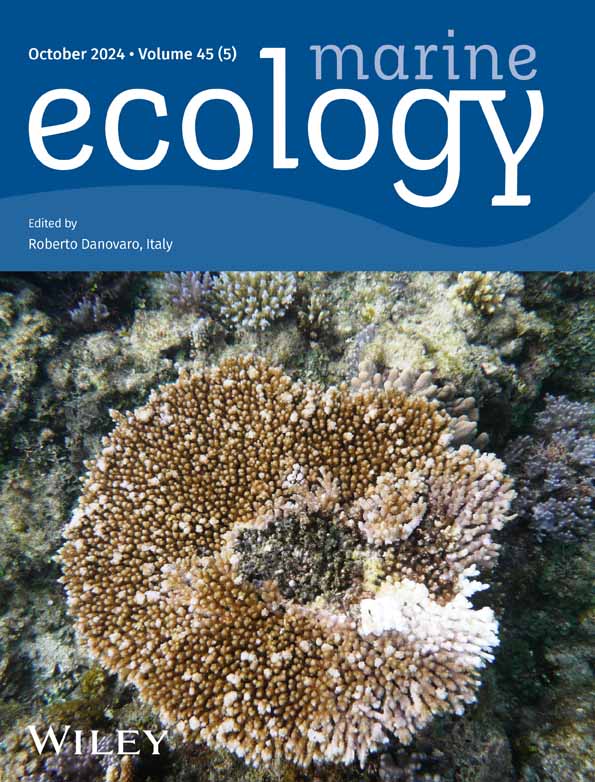Population dynamics of Blood Cockles (Anadara granosa) in the coastal waters of Letman Village, Kei Kecil District, Southeast Maluku Regency
Abstract
The waters of Letman Village, Southeast Maluku Regency are clam fishing grounds which is a source of income for fishermen. One of the shellfish caught is the Blood Cockle (Anadara granosa). The purpose of this study was to analyse and examine the stock of A. granosa clams in Letman village, Kei Kecil District, Southeast Maluku Regency (length and weight frequency) and to determine the mortality rate and exploitation rate of Blood Cockles. This study was conducted between January and June 2022 with a sampling time of once a month for six consecutive months. Random sampling method was used through a free collection at low tide. The total sample collected during the study was 741 individuals. The research data were analysed using FiSAT II program version 3. The smallest size of the sample obtained during the study was 30 mm and the largest was 69 mm. The infinity length (L∞) is 78.50 mm, the growth coefficient (K) is 0.8/year, and the theoretical lifespan of Blood Cockles at a length equal to zero is −0.514/year. Analysis of the total mortality rate (Z) of Blood Cockles (A. granosa) was calculated at 3.90/year with a natural mortality rate (M) of 1.22/year and catchment mortality (F) of 2.68/year, while exploitation rate (E) was at 0.69/year. The addition of new individuals (recruitment) took place every month with varying numbers and the highest recruitment occurred in July and October while the level of exploitation of Blood Cockle in the waters of Letman Village was considered high (overfishing).
1 INTRODUCTION
1.1 Background
Although small islands typically have limited terrestrial natural resources, they hold vast potential for biological and non-biological resources, environmental services, and abundant ocean thermal conversion energy. These assets can be developed to become the nation's economic prime movers. However, the development needs are faced with increasing exploitation of marine resources, leading to environmental and marine resources degradation. Additionally, coastal areas have been transformed into settlements, various industries, ports, hotels, restaurants, capture fisheries and aquaculture, tourism, agriculture, and marine transportation. As a result, the potential development of these small islands needs to be done carefully to avoid decreasing the potential of natural resources or overfishing and physical degradation of the environment.
Kei Kecil Island is located in the northeastern part of Banda Sea and is one of the island groups in the Southeast Maluku Regency. The island's marine ecosystem plays a critical role in the fisheries sector, and several marine animals such as turtles, mantas, and dugongs depend on it. The island is also a feeding ground for leatherback turtles (Dermochelys coriacea) and a key migration route for several species of whales. Letman Village is located in the Kei Kecil District of Southeast Maluku Regency. The area boasts a diverse range of ecosystems, including mangrove forests, seagrass beds, and coral reefs. The coastline spans approximately 2.80 km and is in good condition. The presence of productive ecosystems typical of tropical regions in this village indicates high fisheries potential, including the potential for shellfish resources.
The Blood Cockle (Anadara granosa) is a species of the Genus Anadara that belongs to the Phylum Molluscs, Class Bivalves, Order Arcoida, and Family Arcidae (Broom, 1985). It is found in the Indo-Pacific region, from Africa to Australia, Polynesia, and Japan.
Blood Cockles live mainly in the intertidal zone up to 2 m of water, by burrowing themselves in sand or silt. The A. granosa shellfish is a prized commodity due to its high economic value and significant nutritional content. Fresh clam meat contains 19.48% protein and 2.50% fat, while boiled clam meat blood contains 23.23% protein and 7.01% fat (Nurjanah et al., 2005). This food item is highly sought after by people from diverse regions of Indonesia, including Maluku Province. Consequently, fishermen have been exploiting and hunting clams on a large scale to meet the increasing demand.
According to Nurdin et al. (2006), Blood Cockles inhabit coastal waters with muddy sand substrates in estuary ecosystems, mangroves, and seagrass beds. These clams play a crucial role in the ecology as well as the economy. The ecological aspect of Blood Cockles serves the following functions: (1) as a natural source of food for aquatic organisms; (2) to maintain the stability of aquatic ecosystems; and (3) can be used as an indicator of pollution. Economically, shellfish have the following functions: (1) as part of the mixture for building materials; (2) as industrial raw materials (decoration); and (3) as a source of animal protein for the community.
The Blood Cockle has a soft flattened body with two hard shells that act as body armour. These shells are connected by elastic hinges that enable the body's muscles to open and close, crawl, and dig in mud or sand Daris et al. (2020).
The function and role of Blood Cockles have led to the hunting of these species in nature. Fishermen collect Blood Cockles (A. granosa) without regard for size, resulting in the capture of mostly small specimens. Blood Cockle collection was carried out for a long time and is one of the economic resources of the people in Letman village. The ever-increasing demand from consumers has led to a decrease in the quantity of these Blood Cockles from year to year. The community sells A. granosa clam meat at local markets for prices ranging from Rp 5000–10,000, providing a source of income for fishermen during big wave season. Unfortunately, excessive hunting has led to a decline in the population of Blood Cockles in the area, caused by both fishing and environmental pressures. Although hunting of A. granosa mussels has been ongoing for years, there is a lack of information about their biological condition, making it challenging to develop management efforts to ensure their sustainability. This lack of information is a significant obstacle in establishing preventive measures to safeguard the Blood Cockles from extinction in the future. Therefore, it is essential to conduct research on the Blood Cockle population dynamics to develop effective management strategies for natural resource conservation.
The purpose of this research is to analyse and examine the stock of A. granosa clams in Letman Village, Kei Kecil District, Southeast Maluku Regency. The study will use length and weight frequency data to determine the mortality rate and exploitation of Blood Cockles. This research is expected to provide valuable insights to various stakeholders, including the local government, the Fisheries Office of Southeast Maluku Regency, and students interested in the potential of Blood Cockle stocks in Letman Village. The findings of this study will serve as a reference for the development of the Blood Cockle business and efforts to conserve fisheries and marine resources. The novelty of our research is how to manage the Blood Cockles resource which is threatened with extinction because its utilization rate is very high. Based on the results of previous research, there is information about the growth and mortality aspects of Blood Cockles in Letman Village, but only for 3 months and there is no information about blood cockle resource management based on population dynamics.
2 METHODOLOGY
2.1 Research location and data collection procedure
This research was carried out for 6 months starting from January 2022 to June 2022, in the sandy mud beach of Letman Village Kei Kecil Island, Maluku Province waters during low tide. The location of the study was determined by purposive random sampling based on the location of community exploitation activities that directly affect the presence of Blood Cockles in a tidal area of 0.88 km2. Letman village area is situated between 05°37′51.95″ South Latitude and 132 042′47.14″ East Longitude with an area of about 5.60 km2. Samples are collected using a shovel. The location of the study is presented in Figure 1.
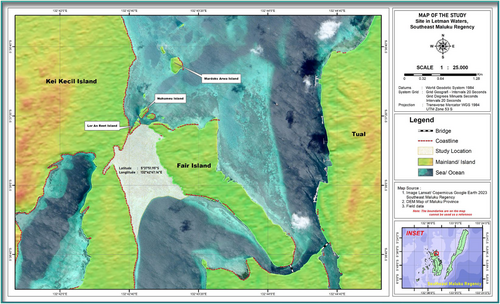
The choice of 6 months for blood cockle sample measurements were taken with the consideration that the types of biota in tropical areas, including blood cockles, have a short lifespan and fast growth. Research by Mulki et al. (2014) carried out measurements of shell growth from the November–December periods (for 3 months) and it was found that the growth of young shellfish was more focused on the shell growth so that the shell growth is faster than the weight growth of the shellfish.
The length of the clamshell from the anterior end to the posterior end (umbo) is used as the measurement of the total length of A. granosa shells. The measurement was done by using a digital calliper with an accuracy of 0.01 mm. Measurements were carried out directly in the field after the samples were collected. Upon completion of measurements, all samples were returned to their original location.
2.2 Data analysis
This study used the Model Class Progression Analysis (MCPA) in the FiSAT II program to estimate the growth of Blood Cockle (A. granossa) in different age groups (cohorts). This method uses mode shifts from a long-frequency data series to analyse growth. This can be illustrated through a long-frequency histogram divided into cohorts. MCPA is a Bhattacharya method used as an initial guess and refined with NORMSEP dividing each component into sample size frequencies.
The Bhattacharya method was used as an initial guess in the analysis of the separation of Blood Cockles age groups based on length measures. This is one of the methods for separating graphical data by length frequency spread data into several normal distributions. Based on Spare and Venema (1998), the allocation of this normal distribution started from the left side of the total distribution and then moved to the right as long as there was still a normal distribution that can be separated from the total distribution.
- Estimating the age of Blood Cockles at birth (t0) was intended to obtain information about Blood Cockles which was contrasted with peak spawning information.
- The value of t0 can be obtained through the values of K and L∞ applied in the equation Log 10(−t0) = −0.3922–0.2752 log10L∞ – 1.038 log10K (Pauly, 1980), (1)
- Natural life span (longevity) is the life span for a species defined by Pauly (1982) as the life span reached by a species in a cohort until 99% of all cohort members reach natural death.
- When Von Bartalanffy's equation was expanded, it resulted in the following the equation = Log10(1–Lt/L∞)/K–t0 (2)
- and if maximum length (Max L) = 0.95(L∞) (3)
- The estimation of total mortality (Z) is determined through a linear relationship between the natural logarithm of changes in the number of Blood Cockles per ith class growing time and age, known as the Length Converted Catch Curve (LCCC) with the formula:
- The addition of the first individuals to the Blood Cockle's population from long-frequency data was aided by an approach method assisted by FiSAT software (Sparre & Venema, 1998). The program reconstructs recruitment pulses from a series of long-frequency data adjusted by the Von Bartalanffy equation (VBGF) to determine the number of pulses per year and the relative strength of each pulse.
3 RESULTS AND DISCUSSIONS
3.1 Growth of Anadara granosa
Analysis of growth parameters based on total shell length data collected for 6 months, using the FiSAT II program, the ELEFAN sub-program obtained an infinity length growth coefficient (L∞) value of 78.50 mm, with a growth coefficient (K) of 0.80 per year. Infinity length or asymptotic length indicates how large the size of the shell can be achieved by an individual clam. The K coefficient, generally of the genus Anadara, is mostly below 0.5 per year. The coefficient K, for A. granosa can be greater than 1.0 per year (Zeinalipour et al., 2014), but the value is still below A. antiquata.
The growth coefficient (K) is an important factor to determine the growth rate of clams reaching infinity size. This value varies between different types of clams, even the difference can occur in the same type with the same location. It can be influenced by factors such as the availability of food resources, habitat suitability, and competition with other organisms that have similar types of food and habitat types. The K value indicates how quickly a species reaches its infinity length or weight (Sparre & Venema, 1998). Based on the K value obtained, it can be concluded that the K growth coefficient in Letman village of Kei Kecil Island is close to one. This suggests that the Blood Cockles is a short-lived organism, and reaching its maximum length is generally achieved over a rapid period of time.
We argue that the rapid growth of Blood Cockles in Letman village is due to ideal environmental conditions. The location is far from urban activities and benefits from the high energy flow of dense mangrove forests and seagrass beds, which are rich in particulate organic matter, thus increasing the phytoplankton community (Saifullah et al., 2016) which is the main energy source for Anadara antiquata as filter feeders.
The entry of organic material is caused by the large amount of litter originating from mangrove forests. Litter and mangrove production is an important part of the transfer of organic material from vegetation into the soil. The nutrients produced from the decomposition process of litter in the soil are very important for the growth of mangroves and other biota that use them as detritus (Nurfakih et al., 2013). According to Emiyarti (2004) in Simanjuntak et al. (2020), states that the grouping of macrozoobenthos that occurs in a body of water is the individual's reaction to different water environmental conditions, both physico-chemical water as well as sediment characteristics and sediment characteristics that influence the grouping of macrozoobenthos, such as type and fraction of sediment, pH (degree of acidity) of waters, and organic matter. Sediment is one of the constituent elements of aquatic areas, has an important role for the life of gastropods and bivalves to determine life patterns, absence, and type of organisms. Organic material and sediment texture determine the existence of Gastropods and Bivalves, where sediment is a place to live, while organic material is a food source, the type of sediment influences the organic material content (Simanjuntak et al., 2020). Marine biota really needs O2 which is used in the process of burning food so that they get an energy source that can be used for activities such as swimming, reproducing, and growing (Haris & Yusanti, 2018 in Santoso et al., 2023).
The optimum dissolved oxygen level for benthic molluscs is 4.1–6.6 ppm, while the minimum level that is still within tolerance limits is 4 ppm (Clark 1974 in Ippah, 2007). The role of oxygen in waters is quite important, namely for respiration, which is also one of the main components for the metabolism of aquatic organisms. The main source of oxygen in waters comes from air diffusion, photosynthesis of phytoplantons, and other aquatic plants as well as incoming rainwater and surface flow (Moriber 1974 in Dody et al., 2000).
Growth parameters (L∞ and K) of Blood Cockles (A. granosa) in other locations have been studied. In Kendari Bay of Southeast Sulawesi (Nasran, 2014), the L∞ growth parameter for male mussels is 65.1 mm with the K value of 0.45, while the female L∞ value is 65.2 mm and the K value is 0.56. In India, (Narasimham, 1988), the L∞ growth value obtained is 73.4 mm and the K value is 0.58, while Efriyeldi and Kurniawan (2023), measured L∞ at 30.45 mm and K at 0.83 in Ransang Barat Riau Province. The value of growth parameters obtained in this study has similar values to those obtained by several previous studies in various places (Table 1). From the data in Table 1, it can be explained that in different locations where Blood Cockles live, the infinity length will be different. The data on the infinity length of the Blood Cockle (Anadara granosa) in the coastal waters of Letman village can be used as preliminary information which serves as baseline data to monitor population parameters in the future.
| Source | L∞ (mm) | Annual growth coefficient (K) | Location |
|---|---|---|---|
| Broom (1985) | 44.4 | 1.01 | Malaysia |
| 49.6 | 0.62 | Malaysia | |
| Ng (1986) | 37.40 | 0.87 | P. Big Support |
| Ng (1986) | 40.50 | 0.79 | Kuala Larut |
| Narasimham (1988) | 73.40 | 0.58 | Kakinada Bay, India |
| Vakily (1992) | 65.1 and 65.2 | 0.54 and 0.86 | Ang Sila, Thailand |
| Brotohadikusumo, (1994) | 48.15 | 0.78 | Wedung, Indonesia |
| Nasram (2014) | 51.75 | 0.34 | Kendari (Southeast Sulawesi) |
| Mirzaei et al. (2014) | 35.40 | 1.1 | Penang Island, (Malaysia) |
| Efriyeldi and Kurniawan (2023) | 30.45 | 0.83 | Ransang West Prov. Riau |
| This study | 78.5 | 0.80 | Kei Kecil (Moluccas) |

Based on some of the parameters obtained earlier, the longevity of Blood Cockles can be determined by elaborating on von Bartalanffy's equation to obtain the equation t = log10(1–Lt/L∞)/K + t0; and when the maximum length (Lmax) = 0.95 (L∞) is included in the equation above, then the longest life span is tmax = 2.9957/K + t0.
The life span (tmax) of Blood Cockles in the coastal waters of Letman Village is 3 years, while the maximum length is 75 mm. By taking into account the maximum age, t life0, K, and L∞, a growth curve conjecture can be formed from the established model and can be seen in Figure 3. Based on this growth chart, it can be seen that Blood Cockles in the coastal waters of Letman Village reach their maximum size at the age of 4 years.
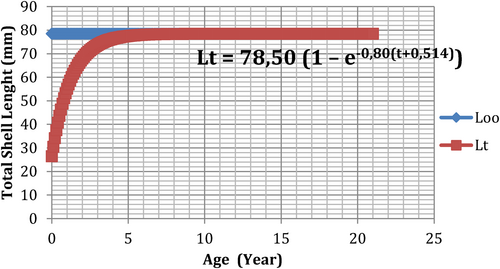
The growth rate of A. granosa in the waters of Letman village is similar to that obtained in the waters of West Rangsang, Riau Province. A. granosa has a growth coefficient (K) value of 0.83 per year and a relatively smaller infinite length (L∞) of 30.45 mm (Efriyeldi & Kurniawan, 2023). However, the growth coefficient in Letman village is relatively small, indicating a slower growth rate compared to several other shellfish.
Tellina foliacea has an L∞ value of 7.70 mm based on von Bertalanffy's growth function, with a K value of 1.20 per year and t0 value of 0.9 years (Negar et al., 2008). This value is lower than that obtained by Kisto et al. (2009), where Polymesoda erosa has a growth coefficient (K) value of 1.20 per year (0.10 per month) and an infinite length (L∞) of 111.25 mm. Natan (2009) obtained growth parameters for tropical mudflat clam (Anodontia edentula), including male, female, and combined asymptotic lengths (L∞) of 65.63 mm, 70.88 mm, 70.58 mm, and growth coefficient (K) values of male, female, and combined 1.3, 1.5, and 1.5 per year.
When compared, the growth coefficient (K) of Blood Cockles in Letman village's waters is higher than that in Kendari Bay obtained by Bahtiar et al. (2022), which is 0.72 per year, and Basri et al. (2019) on Pokea Clam at 0.56. Differences in infinite length and K values can be influenced by differences in aquatic conditions and genetic factors of a biota. According to Nasrawati et al. (2017), old clams in subtropical waters have a slower growth rate and can no longer grow because they have reached their maximum length.
3.2 Mortality
The mortality of Blood Cockles (A. granosa) was estimated using the Length Converted Catch Rate (LCCC), resulting in an equation Y = 11.81 + 3.90X with r = −0.90. The LCCC curve of the Blood Cockles can be seen in Figure 4. The total mortality value (Z) is obtained from the negative slope, with the Z value being 3.90. The overall mortality rate is relatively high, comprising mortality rates from natural causes (M) as well as those resulting from capture or utilization (F). The mortality rate of this animal can be attributed to capture or utilization, as it is highly valued for its economic worth and can be easily traded at a reasonable price. On the other hand, natural mortality is caused by factors such as diseases, predators, and environmental pollution.
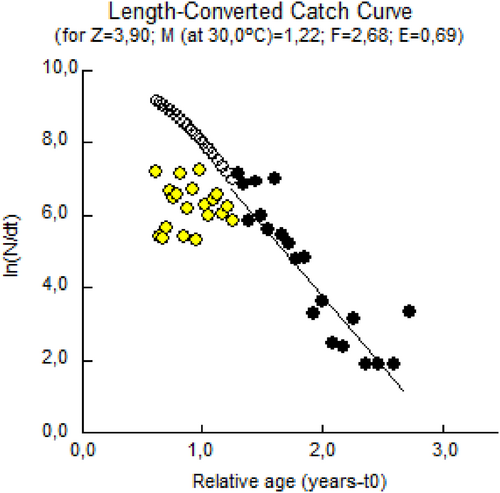
Furthermore, natural mortality (M) based on data on the growth of shell length was obtained at 1.22 per year. With the total mortality (Z) and natural mortality (M) known, the mortality value due to capture (F) and the capture ratio (E) can also be determined. The mortality value due to capture (F) and the ratio of capture (E) was found to be F = 2.68 per year and E = 0.69 per year. This value illustrates that the value of exploitation is already high (overfishing). The exploitation value of Blood Cockles in Letman Village is higher when compared to that obtained by Nasran (2014) in female Blood Cockles at 0.21 per year and also males at 0.07 per year and Efriyeldi & Kurniawan, 2023 Blood Cockles of 0.64 (Table 2). Furthermore, Nuraini et al. (2014), got an E value of 0.76 per year higher when compared to the results obtained in this study, which was 0.69 per year. Gulland (1983) states that if the exploitation rate (E) exceeds 0.5, it is considered a high exploitation rate (overfishing). Alternatively, if the E value is equal to 0.5, it is classified as a low exploitation rate (underfishing).
| Location | Species | Gender | Z | M | F | E | Source |
|---|---|---|---|---|---|---|---|
| Kolong, Karimun, Riau Islands | A. granosa | – | 3.41 | 0.82 | 2.59 | 0.76 | Nuraini et al. (2015) |
| Kendari Bay, Southeast Sulawesi | A. granosa | Male | 2.28 | 1.81 | 0.47 | 0.21 | Nasran (2014) |
| Female | 2.63 | 2.45 | 0.18 | 0.07 | |||
| Penang Island (Malaysia) | A. granosa | – | 3.02 | 1.84 | 0.48 | 0.20 | Mirzaei et al. (2014) |
| Ransang Barat, Riau province | A. granosa | – | 4.46 | 1.60 | 2.86 | 0.64 | Efriyeldi and Kurniawan (2023) |
| Letman Village, Kei Kecil Maluku | A. granosa | – | 3.90 | 1.22 | 2.68 | 0.69 | This study |
The value of F/M ratio, which is over Gulland's theoretical value of 1.0, supports that exploitation has exceeded the optimum limit (Renjithkumar et al., 2011). According to Modou et al. (2013), the stock is in a steady state if Z/K equals 1.0, collapsing if it is above 1.0 and overexploited if the proportion is greater than 2.0. As the Z/K value in this research reached 4.9, which is higher than 2.0, then the current stock is considered over-exploited. Thus, if the level of exploitation of A. granosa (Blood Cockles) in the waters of Letman Village, continues to be carried out on a large scale, there will be changes in the population structure of A. granosa clams eventually. By using length-converted catch curve (Pauly, 1983) using software FiSAT II, from data 6 months' combined length–frequency measurements at each site. FiSAT II outputs Zyear−1 as well as the 95% confidence intervals surrounding Z based on the goodness of fit of the regression. Total mortality is comprised of two components: “natural” mortality (M); mortality due to predation and disease, and “fisheries” mortality (F); mortality due to harvesting by humans, where Z = M + F, its is not to difficult.
This research shows that the decline in blood cockles harvests is largely due to overexploitation of the species. The fishing for blood cockles carried out by the community no longer recognizes seasons. From the results of these arrests, people use it as a source of income and consume it themselves. Therefore, interventions to manage shellfish fishing practices must be carried out to maintain the population, namely by regulating the time of shellfish fishing and the number of fishermen involved. Failure to address this problem could have a detrimental impact on the Blood Cockles population.
Figure 5, showing the logistic selection curve for capture probability, shows selection lengths of 25%, 50%, and 75%, A. granosa from Letman Village, showing that the 50% capture probability or first capture length (Lc) of A. granosa from Letman Village is 49.19 mm. The probability of capture, which is a continuation in the Length-Converted Catch Curve analysis, was analysed using the average value of the shell length (mm), which yielded Lc 25% = 43.31 mm, Lc 50% = 49.19 mm, and Lc 75% = 50.38 mm (Figure 5).
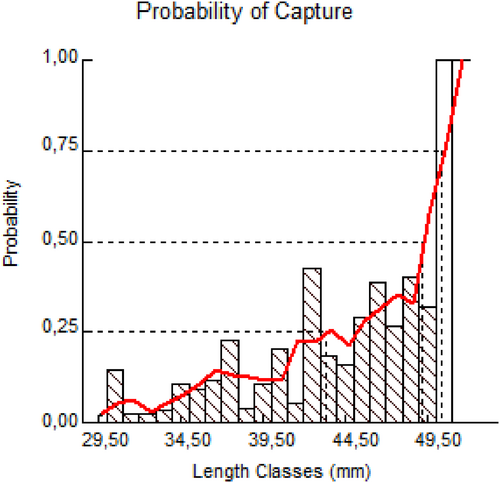
3.3 Recruitment
The analysis conducted with the FiSAT program's recruitment pattern sub-program revealed that new individuals were added (recruited) during the study, which impacted the dynamics of the Blood Cockle's population in nature. The introduction of new individuals is beneficial for the population's stability. Although it is rare to observe juvenile Blood Cockles in nature, the FiSAT program's analysis generated a recruitment percentage (Figure 6), indicating that new individuals were added every month at the study site except for December.
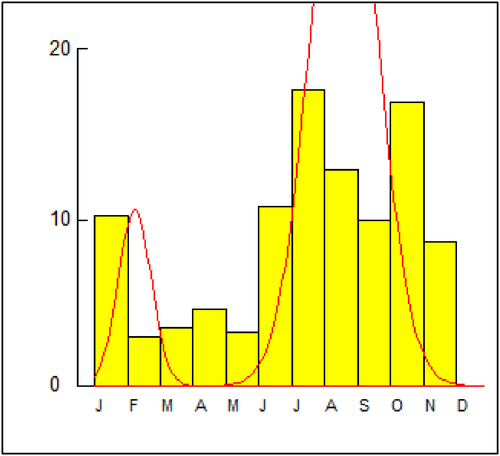
The introduction of new individuals may not be substantial in number, but it is crucial for the sustainability of the clam population in nature. So far, the pressure on the population of A. granosa in the coastal waters of Letman Village not only comes from humans (human influence), but also many are influenced by the interaction of biological factors, such as predators and competition, as well as ecological factors such as environmental changes both naturally and due to human activities (environmental pressure).
Blood Cockles found in the coastal waters of Letman village, Kei Kecil Island show that almost every month there is recruitment, except December. Overall, the largest recruitment (peak recruitment) occurred in July and October, at 17.51% and 16.69% (Figure 6). Thus, it is hoped that the utilization of Blood Cockles should only be in February–May and December each year.
Suwignyo et al. (2005) stated that the life span of veliger larvae as plankton varies from a few days to several months depending on the species before finally descending into the substrate. Afiati (2007) states that the larval period of A. granosa and A. antiquata is relatively short at about 1 month. Keough and Downes 1982 refer to King (1995) stating that in benthic animals, the term recruitment has been used to describe the process of descending into the substrate (habitat) of metamorphosed individuals.
From the recruitment data presented in Figure 6, it is evident that the Blood Cockle population in the coastal waters of Letman village can be sustained. This is because new individuals are added every month, although the number varies. Despite environmental pressures and community catches, this clam population has managed to survive. However, it is crucial to take measures to maintain the stock and prevent its continuous decline.
Recruitment is greatly influenced by the success of spawning, hatching, and growth to the next stage. The success of this process is greatly influenced by water conditions including temperatures due to the rainy or dry season. Nabuab and Del Norte-Campos (2006) state that sexual activity increases in the rainy season, while gamete development occurs in the dry season.
Shellfish recruitment in the tropics can take place every month with varying percentages due to minor variations in monthly environmental conditions. Kastoro and Sudjoko (1988) note that feather clams or mangrove cockle (A. antiquata) are able to spawn throughout the year, as water temperature conditions remain relatively consistent and the biological conditions of the water do not fluctuate.
4 CONCLUSION
The study concluded three things. Firstly, the natural mortality rate of A. granosa Blood Cockles in the waters of Letman Village is lower than the mortality rate caused by capture. Secondly, the exploitation rate of A. granosa shellfish in the waters of Letman Village is classified as high (overfishing) with a coefficient of exploitation rate of A. granosa shellfish of 0.69. Lastly, the addition of new individuals (recruitment) takes place every month with varying numbers and the highest recruitment occurs in July and October.
ACKNOWLEDGEMENTS
Gratitude was given to the village leaders and the Letman village community, for their assistance in providing information to support this research. The same thanks also to Debby A. J. Selanno and Julian Tuhumury as the writing team. The content is entirely the responsibility of the author.
CONFLICT OF INTEREST STATEMENT
None.
Open Research
DATA AVAILABILITY STATEMENT
Data available on request from the authors.



